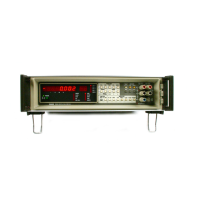8505A
exceed 280V. The potential between SOURCE HI and
SENSE HI, or between SOURCE LO and SENSE LO
must not
exceed
127V.
NOTE
In
current measurements,
the voltage at
the
input
terminals is sampled
before the Current
Shunts module (Option
03)
is connected.
No
connection is made
if
excessive voltage
(±45
V
dc) is present.
2-59.
OHMS
SELECTOR
2-60. When engaged (in), the Ohms Selector isolates
SENSE HI from
SOURCE HI
and
SENSE
LO from
SOURCE LO;
four-wire resistance measurements
can
then be made.
When disengaged (out), SENSE HI
is
connected to SOURCE
HI
and
SENSE
LO is connected
to
SOURCE LO for two-wire resistance measurements.
Refer to
Figure
2-5.
Note that this control should be in the
disengaged (out)
position only when two-wire resistance
measurements are being made. The Ohms Selector has no
control of the rear inputs (a four-wire
configuration
is
preset).
2-61.
REAR INPUT
SELECTOR
2-62. When pushed
in, the Rear Input Selector
disconnects
the front
panel inputs and
connects the rear
input
connector.
The
Ohms
Selector
and Guard Selector
have
no effect
when rear inputs
are
enabled. The
stateof
TffFICeaFlnpirSeleHoFcaFBFsen^HTemotely
through
any
of the
remote interface options.
2-63. Function
2-64.
Selection of a
new function automatically cancels
any
previously selected function and places the
multimeter in the
function change configuration. If the
same function
is successively selected, the multimeter
assumes
the Autoranging mode, but
retains all
other
modes
and values existing
prior
to
the reselection.
A valid
new
function selection
is verified when the appropriate
display
annunciator(s)
lights (V DC,
V
AC, A DC,
A AC,
OH MS, or
V
DC +
V AC). An invalid function selection
occurs
whenever the necessary analog measurement
module
is not
installed or is faulty; either ERROR
9
or
ERROR 3
appears in the display in such cases. Once an
invalid
function has been selected,
the multimeter ignores
all
other push buttons
until
a
valid function is selected.
2-65. Measurement Parameters
2-66.
SAMPLING
2-67.
The
multimeter averages
a
number of samples
for
each
reading (display update). Noise rejection is
influenced by the number of samples-per-reading and by
the filter selection. Each sample-per-reading
setting
yields
a
specific processing time.
Additional processing
time is
necessary when mathematic
operations
(such as OFFSET
or SCALING) are
involved.
Samples taken are
synchronous to the line
frequency
for local operation.
Synchronous or
asynchronous operation can
be specified
remotely.
2-68.
Sample
settings are
specified as exponents
of two.
For
example, the SAMPLE push button
can be
used
individually to toggle
between settings
5
(2
exponent
5
=
32
samples-per-reading) and
7 (2
exponent 7
=
128
samples-per-reading). Further, any
sample
setting
(exponent of
2)
from 0
through 1
7 may be made
using the
STORE
(numeric) SAMPLE sequence.
If a setting
of 0
through
6
is in effect when SAMPLE
is toggled,
the
multimeter assumes setting 7. A previous
setting of 7
through 17 is changed to 5 when SAMPLE
is toggled.
2-69.
The SAMPLE annunciator is
controlled
by both
the sample setting and the trigger. At sample
settings
from
0 through
7,
SAMPLE Hashes once for
each triggered
reading. The rapid reading rate
at 0 or 1 setting
yields an
apparent steady indication. At sample settings
8 through
1
7,
the Hash rate is preset to that
of
setting
7. This
feature
insures a reliable reading-in-progress indication
at these
slower reading rates.
2-70.
TRIGGERING
2-71.
Each new
measurement
is
initiated
with a trigger.
In auto
triggering, each trigger is generated
internally at
the end of the required reading time. Triggers
may also be
applied locally (from the front panel) or remotely.
2-72,
Auto trigger commands a
continuously updated
reading.
The frequency of this updating is
influenced
by
the
number of samples-per-reading and
by any extra
processing time required by mathematic operations.
The
SAMPLE
annunciator
flashes to indicate the triggering
of a new
reading.
2-73. Local triggers can be manually
commanded from
the front panel. The duration of each
reading is
determined
in
the same
manner
as the auto
triggers
(samples,
mathematics).
Each use
of the
MANUAL/EXTERNAL push
button commands
an
immediate response from the multimeter;
any reading
already in progress is aborted and a
new
reading
begun.
During any manually triggered reading,
use of any other
push button halts the multimeter;
a
new
trigger must
then
be entered. Conversely, between manually
triggered
readings, the multimeter is inhibited;
no display update
or
SAMPLE annunciation is evident. During
this interval,
any measurement parameter, mathematic operation,
or
special
operation may
be
entered,
but is not initiated
until
the next manual trigger is entered.
2-74.
External triggers are applied through the
rear
panel TRIGGER jack. A local
trigger
manually
applied
from the front panel overrides
a
simultaneously
applied
external trigger.
2-75.
FILTERING
2-76.
Two
analog filters are available: either one
of
these,
or filter bypass, may be
selected.
The slow filter
provides better
normal
mode
rejection.
The fast filter
allows for
faster instrument settling while still
provid ing a
degree
of
noise rejection.
W'henever
a filter
is
used,
a
2-20

